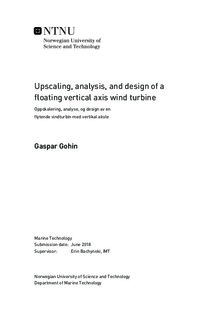| dc.description.abstract | There are currently two main trends governing research and development in the offshore wind industry. The first one is upscaling, i.e. manufacturing larger and more powerful wind turbines; the second one is platform innovation, with floating wind turbines giving access to intermediate and deep water depths. Most of these efforts are focused on horizontal axis wind turbines (HAWT), and the first floating wind farm was commissioned in 2017 using spar-floating HAWTs (Hywind Scotland). Meanwhile, vertical axis wind turbines (VAWT) might be good candidates for upscaling and deep water deployment, as they have a potential for cost reduction due to their lower center of gravity and reduced machinery (no blade pitch system, and no yaw rotor positioning system).
The DeepWind project developed a spar-floating 5 MW VAWT concept, with focus on spar optimization. A control strategy has also been developed for VAWTs, using the generator torque as a control input. However, some difficulties have been faced in the INNWIND project when attempting to upscale the DeepWind VAWT from 5 to 10 MW. Also some numerical integrated analysis of VAWTs have been conducted successfully, combining various fields of research: aerodynamics, hydrodynamics, structural analysis, and control theory. The VAWT module currently available in the numerical analysis tool SIMO presents some technical issues.
In order to investigate the potential advantages of VAWTs for upscaling and spar installation, two tasks were completed: (i) numerical tool verification and improvement (SIMO) and (ii) design and analysis of 5 & 10 MW spar-floating VAWTs. The debugging of SIMO was done in FORTRAN, until a good agreement with the 5 MW DeepWind published results was reached. The design part was conducted with MATLAB for the spar optimization, and with SIMO for the control system optimization, based on a preliminary analysis of the aerodynamic power. The upscaling was made using dimensional analysis, and the resulting models were tested in wind and wave conditions using SIMO. The available models used in SIMO were the Double Multiple Streamtube (DMS) theory for the aerodynamics, Morison s equation for the hydrodynamics, a PI control law and notch filters for the control theory, and rigid bodies and linear stiffnesses for the structural part.
Overall the numerical integrated analysis of the designed models gave satisfying results. Both 5 & 10 MW VAWTs showed (i) increased power output efficiency and stability, and (ii) dynamic stability in wind and wave conditions. Additionally, the spar drafts were minimized to 50m (90m) for the 5 MW (10 MW) VAWT, giving access to intermediate water depths for VAWTs, and a stabilizing gyroscopic effect was identified in floating operating conditions. Finally the upgraded version of SIMO was uploaded, enabling further investigations on VAWTs using SIMA in the future. | |

